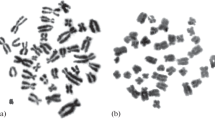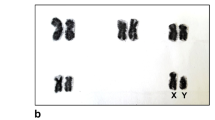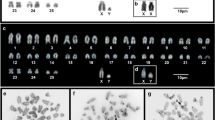Abstract
The chromosome constitutions of 15 forms (2 acrodonts and 13 pleurodonts) of amphisbaenians belonging to two families and eight genera were studied. The diploid chromosome numbers varied from 30 to 44 with the number of chromosome arms (FN) ranging from 42 to 60. The karyotypes of 12 forms all contained 6 pairs of macrochromosomes with similar morphology and 9 to 12 pairs of microchromosomes. The remaining three species had a higher diploid number (40–44) and a wide variation in chromosome morphology. Karyotype variations were found in the same family, even in the same genus. The lengths of the 6 pairs of macrochromosomes in 5 of the 12 forms were measured and compared. This disclosed similarities in the mean lengths, relative lengths, and arm ratios of those forms. — Chromosome patterns found in the present study support, in general, the classification of amphisbaenians derived from analysis of morphological characters.
Similar content being viewed by others
References
Gans, C.: Studies on amphisbaenids (Amphisbaenia, Reptilia). 1. A taxonomic revision of the Trogonophinae, and a functional interpretation of the amphisbaenid adaptive pattern. Bull. Amer. Mus. Nat. Hist. 119, 129–204 (1960); — A checklist of the recent amphisbaenians (Amphisbaenia, Reptilia). Bull. Amer. Mus. Nat. Hist. 135, 61–106 (1967).
Gans, C., and W. G. Lynnt: Comments on the thyroid structure of some acrodont amphisbaenids, with remarks on their systematic status. Herpetologica 21, 23–26 (1965).
—: The diphyletism of the Amphisbaenia (Rep- tilia); A reevaluation based upon chromosome counts. Copeia 2, 485–487 (1967).
Hecht, M. K.: Amphibians and reptiles. In: The geology and paleontology of the Elk Mountain and Tabernacle Butte Area, Wyoming (ed. P. O. McGrew). Bull. Amer. Mus. Nat, Hist. 117, 130–146 (1959).
Matthey, R.: Les chromosomes de l'amphisbénien acrodonte Trogonophis wiegmanni Kaup. Arch. Zool. Expér. Gén. 74, 193–203 (1932); — Nouvelle contribution a l'étude des chromosomes chez les Sauriens. Rev. Suisse Zool. 40, 281–316 (1933); — Les chromosomes des Vertébrés. Lausanne: Librairie de l'Université F. Rouge 1949; — Systématique et critères cytologiques. Les chromosomes de Blanus cinereus Vand. (Lacertilia-Amphisbaenidae) et la méiose de Leucophaea maderae Brun. (Blattaria-Blaberidae). Bull. Soc. Vaud. Sci. Nat. 65, 111–120 (1951).
Moorhead, P. S., P. C. Nowell, W. J. Meliman, D. M. Battips, and D. A. Hun-Gerford: Chromosome preparations of leukocytes cultured from human peripheral blood. Exp. Cell Res. 20, 613–616 (1960).
Shindarov, L.: Tissue culture of kidney epithelium of tortoise (Testudo graeca). C. R. Acad. Bulgare Sci. 15, 539–542 (1962).
Taylor, E. H.: Concerning Oligocene amphisbaenid reptiles. Univ. Kansas Sci. Bull. 34, pt. 1, no. 9, 521–579 (1951).
Vanzolini, P. E.: A systematic arrangement of the family Amphisbaenidae (Sauria). Herpetologica 7, 113–123 (1951).
White, M. J. D.: Animal cytology and evolution. London and New York: Cambridge Univ. Press 1954.
Author information
Authors and Affiliations
Additional information
Supported in part by United Health Foundation of Western N. Y. Research Grant G-66-RP-9, National Cancer Institute, CA-08737 and NSF GB 2460.
Rights and permissions
About this article
Cite this article
Huang, C.C., Clark, H.F. & Gans, C. Karyological studies on fifteen forms of amphisbaenians (Amphisbaenia-Reptilia). Chromosoma 22, 1–15 (1967). https://doi.org/10.1007/BF00291283
Received:
Issue Date:
DOI: https://doi.org/10.1007/BF00291283




